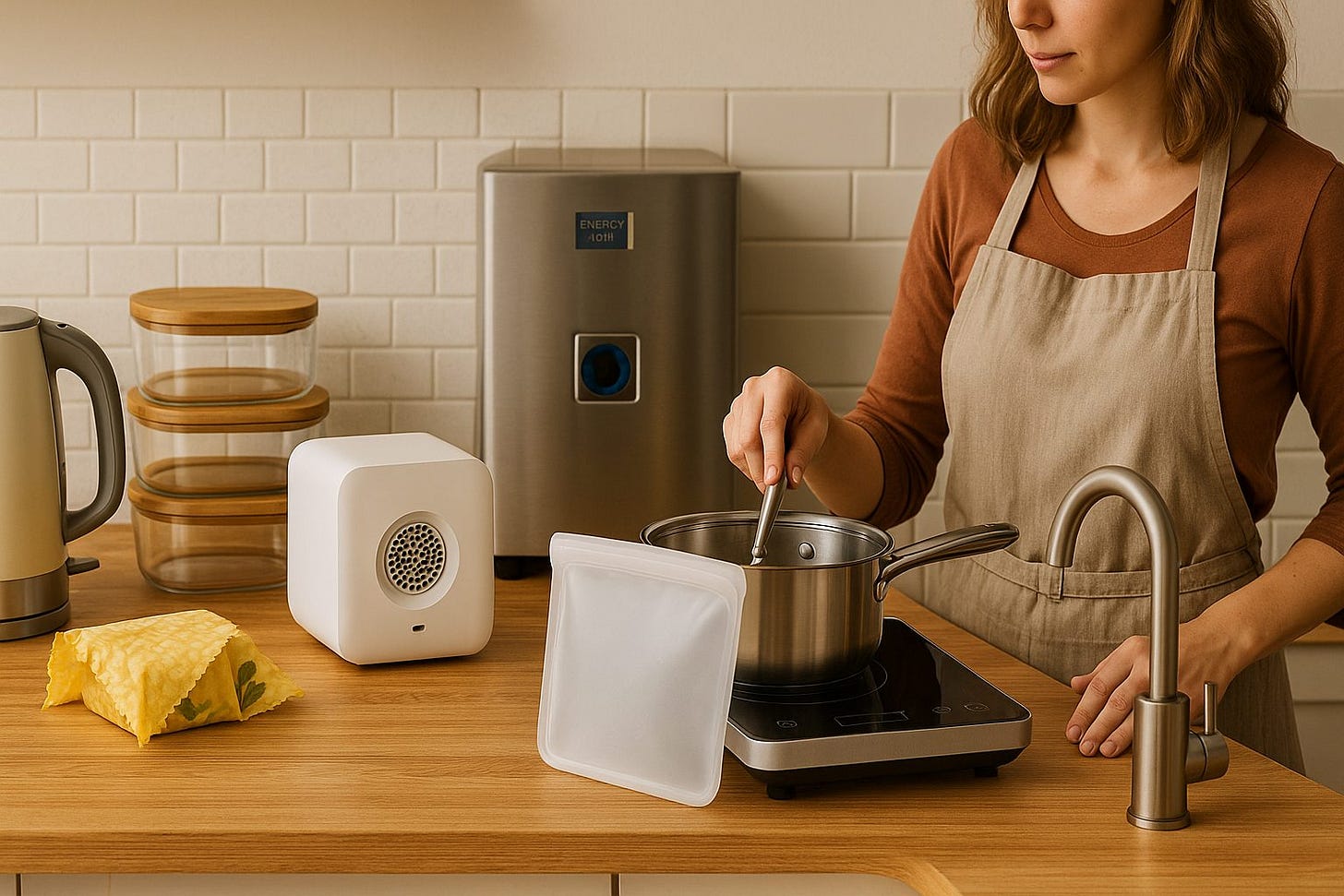5 Eco-Friendly Kitchen Gadgets That Actually Save You Money
Because being green doesn’t have to mean being broke
You love cooking, you hate waste—and your utility bills could use a break. What if I told you there are kitchen gadgets that do more than look cute in your Pinterest board? Gadgets that are smart, sustainable and save you money. I think most of us want that. Here are five eco-friendly kitchen tools that deliver real returns—on both your wallet and the planet. 🌿
1. Induction Cooktops / Burners
The sleek, almost sci-fi-looking burners that work by magnetism, not naked flames or old resistance coils.
Why they're eco-wise:
Induction cooktops convert energy into heat inside the pot, instead of heating the air around it. Less waste. According to the U.S. Department of Energy, switching to induction (from electric resistance or gas) reduces wasted heat substantially, so cooking is more efficient.
They boil water 20-40% faster than gas in many cases, so less time heating = less electricity/gas used.
Where the money-savings come in:
Lower monthly utility bills when frequently cooking (think: two meals a day, several burners on).
Because the cooktop surface stays cool, less need for ventilation; less heat in the kitchen means your AC or cooling costs drop.
Faster cooking = less energy use overall.
Trade-offs / what to check:
Upfront cost is higher than a basic electric or gas stove.
You need compatible cookware (ferrous pans). A magnet test helps.
This is more of a long-term investment. If you cook often, it pays off sooner.
2. Smart Fridge Air Purifier (The "Shelfy")
I know, it sounds fancy. But this is one of those gadgets that earns its stripes.
What it does:
Sits inside the fridge, neutralizes odors, bacteria, fungi, slowing food spoilage.
Has different modes (Eco, Crisper, Performance) and can be controlled via an app.
Filter is washable (so you're not buying replacements every few months).
Savings you get from it:
Less food thrown out. If your vegetables and fruits stay fresh 4-7 more days, that's more meals, less waste, fewer grocery runs.
Fewer emergency buys of wilted produce (yes, I see you tossing the bag of spinach).
Indirect energy savings since spoiled food wastes the energy that went into growing, transporting, cooling, etc.
Caveats:
It costs (one-time purchase + occasional charge). You have to decide whether your food waste is high enough to make it worth it.
Size matters: in a large fridge you might need more than one, and in small fridges it takes up space.
3. Reusable & Natural Food Storage (Glass, Silicone, Beeswax Wraps, etc.)
These aren't flashy gadgets with blinking lights, but their impact adds up.
What they replace:
Single-use plastics (plastic wrap, disposable bags).
Cheap containers that warp or crack quickly.
Benefits:
One good glass container or silicone bag lasts years. Replace dozens of throw-away ones.
Keeps food fresher (glass doesn't leach chemicals; beeswax wraps breathe a little).
You can freeze, reheat safely in many cases.
Typical return on investment: months to a year, depending on how much you were using disposables.
4. Energy-Efficient Dishwashers with Eco-Cycles
Hand washing has its place (someday), but for many of us, a good dishwasher can be more eco friendly when used right.
What to look for:
ENERGY STAR rated models. These use less water + energy.
"Eco" or low-temperature settings for lightly soiled dishes.
Designed for full loads (don't run it half full).
How they save you money:
Less water used = lower water + heating bills.
Less wear on dishes/glasses (dishwasher gentler than some hand-scrub abuse).
Over time, the cost difference between running eco cycles vs standard cycles adds up.
5. Smart / Auto-Shutoff Kettles & Low-Flow Water Fixtures
These are simple, but small leaks or waste can quietly drain your budget (and the planet's patience).
What they do:
Kettles that detect when water is boiling and turn off automatically.
Low-flow faucet heads or sensor faucets (only running water when needed).
Where savings hide:
Less energy used to reheat water you don't need.
Less water wasted which also means less hot water to heat.
If you pay for sewer by volume, that drops too.
Big Picture: Choose Smart, Use Smart
A tool is only as effective as how it's used. To really save money and be eco friendly:
Buy only what you will use regularly. An expensive gadget sitting unused is money wasted.
Maintain your gadgets. Clean, fix, don't toss. A well-cared induction cooktop, well-sealed fridge, etc.
Combine habits. Even with gadgets, behavioral changes (closing fridge quickly, matching pot size to burner, loading dishwasher smartly) boost savings.
Also read: 6 Eco-Friendly Kitchen Swaps That Actually Work (and Don't Suck)
Final Verdict
If I had to pick one gadget that delivers the highest return per dollar, induction cooking wins first. Then I'd add the Shelfy (if you often throw out food). The others are important pieces in an eco puzzle.


